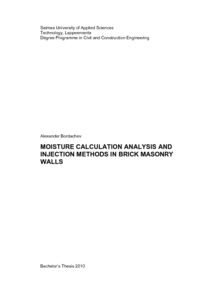Moisture Calculation Analysis and Injection Methods in Brick Masonry Walls
Bordachev, Alexander (2010)
Bordachev, Alexander
Saimaan ammattikorkeakoulu
2010
All rights reserved
Julkaisun pysyvä osoite on
https://urn.fi/URN:NBN:fi:amk-2010082512769
https://urn.fi/URN:NBN:fi:amk-2010082512769
Tiivistelmä
The main aim of the thesis was to study solid brick masonry cellar walls with high water content and determine possible ways to reduce water content. Evaluation was done via the WUFI 2D 3.3. In addition, my task was to investigate most common repairing methods respective of moisture problematic in brick structures.
In the thesis solid brick masonry wall with normal lime cement plaster on both interior surfaces in the cellar have been considered. Then was determined the time from which structure absorb maximum amount of water and became in the equilibrium conditions. After that we used rehabilitation technologies to reduce already known total amount of water, such as plasters with high porosity and water proofing injections. The main problem was necessity to create climate file respective water level conditions. In my work injection technologies respective of moisture in cellar walls have also been considered.
The results of the study show that the best method for repair cellar walls with high dampness, caused by rising capillary water, is using high porosity plasters with horizontal damp proofing (injection). Results which we get show that WUFI 2D can be used for modelling rising water in the cellar walls with satisfactory accuracy. Also very interesting dependence between temperature and relative humidity on the different sides of the structure was observed. The presence of different temperatures on the surfaces sufficiently increase total amount of water in the structure.
Different types of injection technologies were considered: pressure injection, unpressurised injection and impulse injection. All considered technologies have got limits of applicability and their own advantages and disadvantages. But can be distinguished impulse injection technology, which has got a lot of advantages, for instance: preparation of the masonry, such as the filling of cavities, is not necessary; the injection process is controlled electronically and the method runs autonomously.
In the thesis solid brick masonry wall with normal lime cement plaster on both interior surfaces in the cellar have been considered. Then was determined the time from which structure absorb maximum amount of water and became in the equilibrium conditions. After that we used rehabilitation technologies to reduce already known total amount of water, such as plasters with high porosity and water proofing injections. The main problem was necessity to create climate file respective water level conditions. In my work injection technologies respective of moisture in cellar walls have also been considered.
The results of the study show that the best method for repair cellar walls with high dampness, caused by rising capillary water, is using high porosity plasters with horizontal damp proofing (injection). Results which we get show that WUFI 2D can be used for modelling rising water in the cellar walls with satisfactory accuracy. Also very interesting dependence between temperature and relative humidity on the different sides of the structure was observed. The presence of different temperatures on the surfaces sufficiently increase total amount of water in the structure.
Different types of injection technologies were considered: pressure injection, unpressurised injection and impulse injection. All considered technologies have got limits of applicability and their own advantages and disadvantages. But can be distinguished impulse injection technology, which has got a lot of advantages, for instance: preparation of the masonry, such as the filling of cavities, is not necessary; the injection process is controlled electronically and the method runs autonomously.
